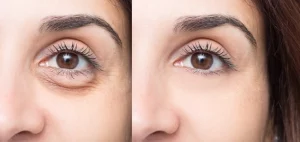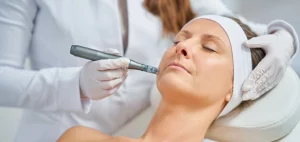In the world of non-surgical cosmetic treatments, Kybella has emerged as a revolutionary solution for those seeking to eliminate submental fat, more commonly known as a double chin. This minimally invasive procedure offers outstanding results, but it’s essential to understand the post-treatment experience fully.
In this blog, we’ll understand the science behind Kybella, its benefits, and most importantly, the duration of swelling – a concern for many considering this treatment. At Syra Aesthetics, we pride ourselves on offering safe and effective Kybella treatments.
What is Kybella?
Kybella is an FDA-approved injectable treatment specifically designed to target and eliminate stubborn fat beneath the chin. It’s a synthetic form of deoxycholic acid, a naturally occurring molecule in the body responsible for breaking down and absorbing dietary fat. When injected into the fat beneath the chin, Kybella works to destroy fat cells, which are then gradually eliminated by the body’s natural processes.
How Does Kybella Work?
Kybella has consistently exhibited its greatest efficacy in breaking down fat cells. The treatment begins with a series of small injections into the targeted area. Over the following weeks, the deoxycholic acid gets to work, disrupting the fat cell’s membranes, causing them to burst. Once this happens, the body recognizes the damaged fat cells as waste and gradually eliminates them. This process results in a noticeable reduction in the appearance of a double chin.
Kybella Benefits
Kybella offers a range of benefits that make it an attractive option for those looking to improve their chin profile:
Non-Surgical: Unlike traditional liposuction, Kybella is non-surgical, which means no incisions, stitches, or downtime.
Customizable: The number of Kybella treatments required can be tailored to each patient’s specific needs and goals.
Natural-Looking Results: Kybella provides gradual and natural-looking results, avoiding the telltale signs of sudden cosmetic changes.
Minimal Discomfort: While some discomfort and swelling are expected, the recovery period is generally shorter and less painful than surgery.
Long-Lasting Results: Once the fat cells are eliminated, they do not return, providing long-lasting results.
How Long Does Kybella Swelling Last?
One of the most common concerns among individuals considering Kybella is the duration of post-treatment swelling. It’s important to note that swelling is a typical side effect of Kybella, and its duration can vary from person to person. Typically, patients experience swelling for about 2 to 4 weeks after their treatment. This initial swelling may be more noticeable in the first few days following the procedure.
To manage swelling, it’s essential to follow post-treatment instructions provided by your healthcare provider. This may include applying ice packs, avoiding strenuous activities, and sleeping with your head elevated. It’s important to note that while you may notice swelling during this period, the final results of your Kybella treatment will not be fully visible until the swelling has subsided.
Side Effects of Kybella
As with any medical procedure, it’s important to be well-informed about the potential side effects before undergoing Kybella treatment. While Kybella is a safe and FDA-approved option for eliminating submental fat, it’s not without its possible side effects.
Here, we’ll explore what you can expect and how to manage any side effects that may arise during your Kybella journey.
1. Swelling: Swelling is one of the most common side effects of Kybella. It typically occurs in the treatment area and can be more pronounced during the first few days following the procedure. However, this swelling is a positive sign that Kybella is doing its job. It’s your body’s natural response to the treatment, as it begins to break down and eliminate fat cells.
2. Bruising: Some individuals may experience bruising at the injection site. This is normal and usually resolves on its own within a week or two. To minimize the risk of bruising, it’s advisable to avoid blood-thinning medications and supplements in the days leading up to your treatment.
3. Redness and Tenderness: You might notice some redness and tenderness in the treated area. This is a common side effect and is usually temporary. It’s a sign that your body is responding to the Kybella injections. Over-the-counter pain relievers and cold compresses can help alleviate any discomfort.
4. Numbness: It’s not uncommon to experience numbness or a loss of sensation in the treatment area. This is generally a temporary side effect and is due to the disruption of fat cells and nerves. The sensation typically returns as the body heals.
5. Hardness or Lumps: Some patients may develop small, firm areas or lumps in the treated area. This is usually a sign of the fat cells being broken down and is temporary. Your healthcare provider can assess these areas and may recommend massage or additional treatments if needed.
Conclusion
In conclusion, Kybella is a highly effective and non-surgical solution for reducing submental fat and achieving a more defined chin profile. While swelling is a common side effect, it typically lasts for about 2 to 4 weeks and can be managed with proper care.
At Syra Aesthetics, we specialize in Kybella treatments and are committed to providing our patients with safe and exceptional results. If you’re interested in all the benefits Kybella offers, contact us today to schedule a consultation.
– Disclaimer –
This blog is for informational & educational purposes only, and does not intend to substitute any professional medical advice or consultation.
For any symptoms or medical advice, please consult with your physician,
Or Book an appointment with our board-certified aestheticians at Syra Aesthetics.
Read more about Kybella:

About The Author
Dr. Syra Hanif M.D.
Board Certified Primary Care Physician
Dr. Hanif is the Director of Aesthetic Medicine. She is a board-certified physician in Aesthetic Medicine who specializes in using non-surgical alternatives in order to enhance one's appearance through Botox and fillers.
Read More











